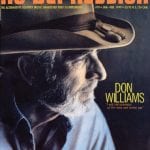J.D. Crowe – The New South will rise again
J.D. Crowe is old enough to remember when bluegrass was the new thing. He says he knew he wanted to be a bluegrass musician the very first time he heard Earl Scruggs play the banjo on the Kentucky Barn Dance radio show. Crowe was 13 at the time and playing electric guitar in local country/hillbilly bands in his hometown of Lexington, Kentucky.
It was 1951 and, as he reminds me, “This was before rock ‘n’ roll.” He began attending all of Flatt & Scruggs’ frequent Lexington performances, sitting in the front row and carefully studying Scruggs’ new three-finger banjo style. Something about Scruggs’ playing, he says, “kind of hooked me. There was no other sound like that. So I dropped the guitar and got into the banjo.”
Over 40 years later, Crowe is still into the banjo, and still making some of the finest, freshest bluegrass music around. He has just released a new album on Rounder, Come On Down To My World, his second since ending a six-year hiatus from the music business (brought on after years on the road had left him “burnt out for awhile,” he says).
But he never intended this break as a retirement, he says — “just sort of a leave of absence.” Now he’s back, well-rested and energetic, with more projects in the works. And with the latest version of his band, the New South, he’s back on the road and says he’s “enjoying touring more than I have for awhile. I’m not as intense about it as I used to be. I’m trying to enjoy it more and not push so hard.”
Crowe’s major contribution, besides his exceptional banjo playing, has been his infusion of country and country-rock influences into bluegrass. He has always set his sights beyond pure bluegrass, and long been outspoken in his desire to broaden the musical (and commercial) boundaries of bluegrass.
He says he listens to all kinds of music, especially the hard-country sounds he calls “the good stuff”: Merle Haggard, Buck Owens, Marty Robbins, Gene Watson, Waylon Jennings, Lefty Frizzell. Crowe has never drawn distinctions, as some purists do, between country and bluegrass: “It’s all just country to me.” His ears have been open to rock music as well, and over the years he’s recorded songs by everyone from Chuck Berry and Fats Domino to Bob Dylan and Gram Parsons.
Come On Down To My World contains just the sort of eclectic mix of bluegrass, country and beyond that we’ve come to expect from Crowe. Although he calls it more of a “straight grass album” than 1996’s Flashback, a Grammy-nominated effort on which he revived a number of tunes from his early years, the new release covers a wide spectrum of American music from Flatt & Scruggs to W.C. Handy. It features straight-ahead country fare such as “I’m So Afraid of Losing You Again”, an old Dallas Frazier tune previously recorded by Charley Pride and others; and Merle Haggard’s “Back To The Barrooms”, a song Crowe says “I’ve always wanted to do. It adapted real good to the grass sound.”
A highlight, and another example of Crowe’s wide-ranging musical interests, is a hard-driving take on Townes Van Zandt’s “White Freight Liner”, with soaring vocal harmonies and fast picking that take the song a long way from the Texas blues of Van Zandt’s original. A longtime mentor to aspiring bluegrass artists, Crowe has assembled another outstanding band for this album, including Greg Luck on guitar and lead vocals, Dwight McCall on mandolin and vocals, Phil Leadbetter on dobro, Curt Chapman on bass, and Glenn Duncan on fiddle.
For all the talk of tradition in bluegrass music, the bluegrass tradition is actually a rather young one. What we recognize today as the classic bluegrass sound goes back only as far as the mid-1940s, when Bill Monroe assembled the definitive Blue Grass Boys lineup with Earl Scruggs on banjo, Lester Flatt on guitar and lead vocals, Chubby Wise on fiddle, Cedric Rainwater on standup bass, and Monroe on mandolin. Although it can sound as old as the hills, bluegrass is a very modern music, not much older than rock ‘n’ roll.
Just two years younger than Elvis, Crowe was born in the pre-rock era but came of age with the birth of rock ‘n’ roll. As a teenager, he recalls listening to artists such as Ricky Nelson and Fats Domino. And he wasn’t alone in those days in his fondness for both bluegrass and rock ‘n’ roll. Remember that Elvis himself recorded a memorable version of Bill Monroe’s “Blue Moon Of Kentucky” at Sun Studios in 1954. And if Elvis was the first to bring bluegrass into rock ‘n’ roll, Crowe was among the first to bring rock into bluegrass. In the late ’50s, he played Little Richard songs such as “Long Tall Sally” at shows with Jimmy Martin & the Sunny Mountain Boys. The bluegrass audiences, he says, loved it.
Like Elvis, Crowe hit the big time in 1954, when Martin was driving through Lexington and heard him playing the banjo on a local radio station. Crowe had started playing professionally within a few years of first picking up the banjo and was appearing regularly on Esco Hankins’ weekly radio show on Lexington’s WLAP. Martin immediately called the station and asked the 15-year-old to join his group for a summer tour.
“I wasn’t with Jimmy that long, then,” says Crowe, “because I had to go back to school.” The following summer, Crowe further honed his skills with another bluegrass legend, singer-guitarist Mac Wiseman, who was based out of WRVA in Richmond, Virginia. But as soon as Crowe finished high school, Martin called again and offered to make him a full-time member of the Sunny Mountain Boys.




